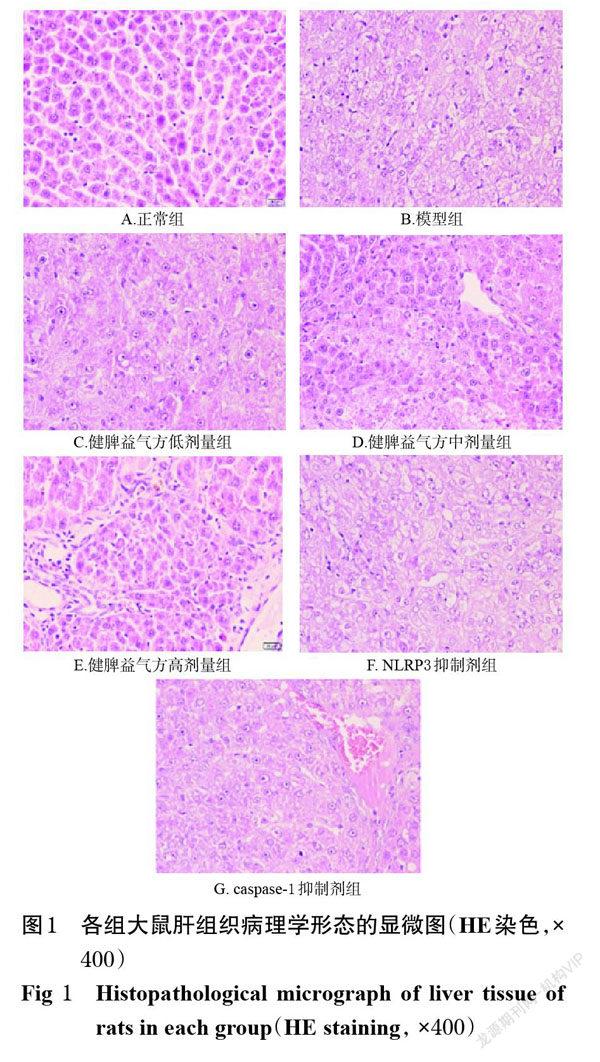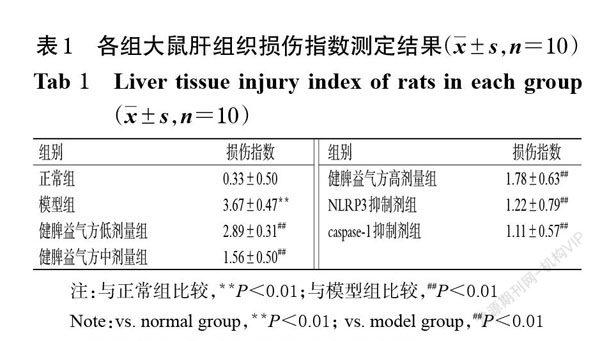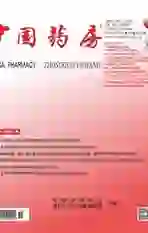健脾益气方对肝癌模型大鼠的治疗作用及机制研究
2021-10-15王超岳紫晨音金萍蒋筱卓少元
王超 岳紫晨 音金萍 蒋筱 卓少元



中图分类号 R285.5 文献标志码 A 文章编号 1001-0408(2021)19-2342-05
DOI 10.6039/j.issn.1001-0408.2021.19.06
摘 要 目的:探讨健脾益气方对二乙基亚硝胺(DEN)诱导的肝癌模型大鼠的治疗作用及机制。方法:将80只雄性SD大鼠分为正常組、模型组、NOD样受体家族3(NLRP3)抑制剂组(MCC950,4.5 mg/kg)、胱天蛋白酶1(caspase-1)抑制剂组(VX-765,4.5 mg/kg)和健脾益气方低、中、高剂量组(5.25、10.5、21 g/kg),除模型组20只大鼠外(其中10只用于判断是否造模成功),其余每组10只。除正常组大鼠腹腔注射生理盐水外,其余各组大鼠腹腔注射DEN(70 mg/kg)以复制肝癌模型。造模成功后,正常组和模型组大鼠灌胃生理盐水,各抑制剂组大鼠腹腔注射相应药物,健脾益气方各剂量组大鼠灌胃相应药物,每日1次,连续4周。末次处置后,观察大鼠肝组织病理学形态变化,检测大鼠血清中肿瘤坏死因子α(TNF-α)、白细胞介素1β(IL-1β)的含量,检测大鼠肝组织中NLRP3以及细胞程序性坏死相关蛋白[衔接子凋亡相关斑点样蛋白(ASC)、caspase-1前体(pro-caspase-1)、受体相互作用蛋白激酶1(RIP1)、RIP3、混合系激酶区域样蛋白(MLKL)]的表达水平。结果:与正常组比较,模型组大鼠的肝细胞可见不同程度的脂肪变性、细胞核增大和呈团块状,部分可见出血和坏死,并伴有增生灶和结节;其肝组织损伤指数和血清中TNF-α、IL-1β含量以及肝组织中NLRP3、ASC、pro-caspase-1、RIP1、RIP3、MLKL蛋白的表达水平均显著升高(P<0.05或P<0.01)。与模型组比较,健脾益气方低、中剂量组大鼠的肝组织仍有大量炎性细胞浸润,而其高剂量组和各抑制剂组大鼠的炎性细胞浸润均明显减少;且健脾益气方各剂量组和各抑制剂组大鼠的肝组织损伤指数和血清以及肝组织中上述指标水平大部分显著降低(P<0.05或P<0.01)。结论:健脾益气方对肝癌模型大鼠具有治疗作用,其作用机制可能与下调NLRP3炎症小体的表达、抑制细胞程序性坏死有关。
关键词 健脾益气方;肝癌;NOD样受体家族3炎症小体;程序性坏死
Study on Therapeutic Effects and Its Mechanism of Jianpi Yiqi Decoction on Liver Cancer Model Rats
WANG Chao1,2,YUE Zichen1,YIN Jinping1,JIANG Xiao1,ZHUO Shaoyuan1(1. School of Basic Medicine, Guangxi University of TCM, Nanning 530200, China; 2. Guangxi Key Laboratory of Integrated Traditional Chinese and Western Medicine Translational Medicine for High Incidence Infectious Diseases, Guangxi University of TCM, Nanning 530200, China)
ABSTRACT OBJECTIVE: To explore the therapeutic effects and its mechanism of Jianpi yiqi decoction on diethylnitrosamine (DEN) induced liver cancer model rats. METHODS: Totally 80 male SD rats were divided into normal group, model group, Nod-like receptor family 3 (NLRP3) inhibition group (MCC950,4.5 mg/kg), caspase-1 inhibitory group (VX-765,4.5 mg/kg), Jianpi yiqi decoction low-dose, medium-dose and high-dose groups (5.25, 10.5, 21 g/kg), with 10 rats in each group except for 20 rats in model group (10 of them were only used to judge whether modeling was successful). Rats in each group were intraperitoneally injected with DEN (70 mg/kg) to induce liver cancer model, except for the rats in normal group which were replaced by normal saline. After modeling, normal group and model group were given normal saline intragastrically; inhibitor groups were given relevant medicine intraperitoneally; Jianpi yiqi decoction groups were given relevant medicine intragastrically, once a day, for consecutive 4 weeks. After last administration, histopathological morphology of liver tissue was observed. The contents of serum inflammatory factors TNF-α and IL-1β were detected. The expression of NLRP3 and programmed cell necrosis associated protein (ASC, pro-caspase-1, RIP1, RIP3 and MLKL) in liver tissue were detected. RESULTS: Compared with the normal group, the hepatocytes of model group showed varying degrees of steatosis, enlarged nuclei, lumpy, bleeding and necrosis, accompanied by proliferative foci and nodules. Liver tissue injury index, serum content of TNF-α and IL-1β as well as the protein expression of NLRP3, ASC, pro-caspase-1, RIP1, RIP3 and MLKL in liver tissue were significantly increased (P<0.05 or P<0.01). Compared with model group, there were still a large number of inflammatory cell infiltration in the liver tissue of rats in Jianpi yiqi decoction low-dose and medium dose groups, while the inflammatory cell infiltration of rats in high-dose group and inhibitor groups decreased significantly; the liver tissue injury index and above indexes levels in serum and liver tissue were decreased significantly (P<0.05 or P<0.01). CONCLUSIONS: Jianpi yiqi decoction shows therapeutic effect on liver cancer model rats, the mechanism of which may be associated with down-regulating the expression of NLRP3 inflammasome and inhibiting programmed cell necrosis.
